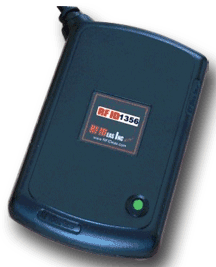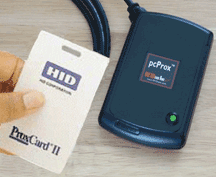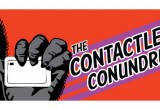RF Ideas enables use of prox and contactless cards for logon, payment, and legacy ID
24 May, 2005
category: Biometrics, Contactless, Corporate, Financial, Library
 Do you use prox or contactless cards for access control and wish you could use them for other applications as well? You are not alone – thousands of corporations, campuses, and agencies are in the same boat. But a Chicago-based company, RF Ideas, may have a solution in their line of programmable devices that read and write data between cards and PCs.
Do you use prox or contactless cards for access control and wish you could use them for other applications as well? You are not alone – thousands of corporations, campuses, and agencies are in the same boat. But a Chicago-based company, RF Ideas, may have a solution in their line of programmable devices that read and write data between cards and PCs.
RF Ideas provides desktop and embedded proximity card readers and software. This includes the pcProx USB, RS-232 and Software Developers Kit (SDK). The company has delivered several hundred SDKs that enable further development of application solutions typically solved by magnetic stripe, bar codes, and smart cards. RF IDeas and its integration partners–some of the largest smart card producers in the world, such as HID and Indala–can provide turnkey solutions for manufacturing, healthcare, security and general office environments that need flexible ID cards.
“Most of our large deals involve someone using our developer kit directly,” said Mr. Giliniecki. “Our readers connect to PCs that, for example, support HID badges. We’re the go-to guys if you want to connect a (prox or contactless) reader to something besides a control panel.”
“When we started in 1996, we had an active badge solution that included a battery and a receiver on the PC. We wrote our own software which included a PC logon application,” said Mr. Gliniecki.
PcProx makes logical access ‘touchless’ with proximity cards
In 2000, HID and RF Ideas, Inc., announced a collaboration “to bring proximity access control to PCs and computer networks using the same HID proximity cards that control physical access to facilities,” said Mr. Gliniecki.
“(HID) had the same vision as us, that is using an access card for more than just accessing the door.” said Mr. Gliniecki. “Before that we sold copy protection devices. It was very easy to port over and support these prox cards. We basically use some core technology we purchased from HID to read their cards.”
Called pcProx, the system consists of a proximity card reader connected to a PC to enable users to place their proximity cards on the reader and, if required by the system administrator, enter a password. The software verifies their identity and access rights and allows them to use the PC.
By enabling the use of existing HID physical access control cards, the pcProx system allows companies to leverage their access control infrastructure and provide the same protection for their corporate data as they have for their physical facilities. The system, according to RF IDeas, is compatible with the estimated 65 million HID proximity cards in use around the world.

Multi-application capability using contactless cards
AIR ID is the name of the product line that supports the 13.56 Mhz contactless technology, specifically HID’s iClass platform. It is designed to meet its customers’ needs for multi-application solutions. The reader enables cashless vending, biometrics, time and attendance, alarm system control, process control, PC log-on, mag-stripe emulation, and point-of-sale terminals. It also allows users to leverage their existing access control system while upgrading to new applications and technologies, leading to just one card for employee ID, PC access, and vending. For non-access control applications, the AIR ID reader can read or write to any application area on an HID iCLASS credential, said Mr. Giliniecki.
With AIR ID, “you can put your user name and password in the card. All this can be configured on the fly,” said Mr. Gliniecki. “Our AIR ID playback reader will keystroke data to a particular application area. You can configure the reader, or have readers configured differently. Say for time and attendance, you can get the data from the time and attendance area on the badge.” Or in a cafeteria, another part of the badge can be used for payment purposes, he added.
Emulating keystroke data with prox and contactless cards
One of the most useful applications of RF Ideas offering is the ability to extract data from a prox or contactless card and ‘trick’ a computer into thinking that data was entered on the keyboard. By plugging a “keyboard wedge” into a PC, data read from the card is sent to the computer in a manner that mirrors keystoke data. To the computer, it appears as if actual keyboard characters (e.g. passwords, credential numbers) were physically typed in.
“A lot of our stuff can be used in keyboard wedge mode. This normally plugs into a USB or serial port, then you simply use your prox card data as your password,” he said. “For those afraid of losing the prox card, we can add a couple of characters” after the password that the user has to manually input, said Giliniecki.
The ability to emulate keystroke data from the card can enable a rapid, straightforward means to build the convenience and security of the card into legacy applications that require data entry. Time and attendance, library patron identification, logon, and a host of other applications could be supported.
“(The question) we like to pose is ‘why aren’t you using prox badges for that purpose?’ Anyplace where you need this capability, that card can become the single identifying credential through the whole work place,” concludes Mr. Gliniecki.
Additional Information:
To learn more about the RF Ideas offerings, click here.




